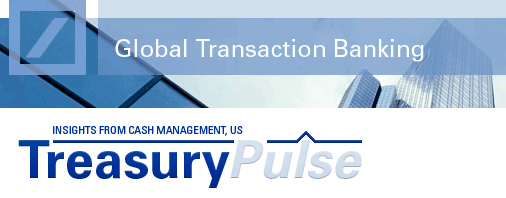 |

|
|
Strategies for Managing the Long-Term Risk of US Dollar Appreciation For the past half dozen years or so, many US corporations have enjoyed a huge windfall of profits due to the depreciating dollar boosting their foreign revenues. With many economists suggesting that the dollar downturn may soon run its course, how do such companies now manage the long-term risk of US dollar appreciation? Since February 2002, the dollar has declined more than 30% against other major world currencies, according to the Federal Reserve's Price-Adjusted Major Currencies Dollar Index. For some US firms, the weak dollar cycle was a significant contributor to profitability. But now experts say the most likely long-term direction for the dollar is up. So what actions can corporations take to hedge against the possibility of a strengthening dollar? Here are three hedging strategies to consider: Revise Debt Mix Let's say your capital structure is comprised of US dollar debt and revenues in both US dollars and euros. To hedge against US dollar appreciation, now might be a good time to add euro debt to the mix. If you take this step, and the dollar makes its anticipated comeback, it will be cheaper for you to pay off the company's euro-based debt. The strategy also provides a hedge of your cash flows, by giving you a liability in euros (the debt) to match an asset in euros (the euro revenue stream). One Deutsche Bank client recently implemented this strategy. The company's borrowing had been 100% US dollar based, and its revenue mix had been 60% euro based and 40% dollar based. During the years of the dollar's slide, this structure worked well. As the dollar fell, the company had euro revenue coming in, which made it easier to pay off dollar based debt. Now, however, with concerns about dollar appreciation, the company has revised its debt mix to 60% euro based and 40% dollar based, to create a capital structure where debt and revenues match very closely. Expand Hedge Horizon For example, if your company has revenues in euros, and you believe euros are close to peaking in value relative to the dollar, it might make sense to lock in that foreign exchange advantage for as long as possible. So if your company today is hedging out 12 to 24 months, you might want to consider extending that hedge to 24 to 36 months. Or if you're currently hedging out to 36 months, maybe you want to go out to 48 months. A Deutsche Bank client in the data storage space recently opted for this strategy, extending its hedging of foreign revenues from 6 months to 12 to 18 months. Pursue a Net Investment Hedging Strategy A telecommunications company in the Midwest with a European subsidiary has pursued this strategy. The European subsidiary had built up a cash position of about 100 million euros. Back in late 2002, that 100 million euros would have been worth about $100 million, but with the dollar's decline, today it's worth around $154 million. With the prospects being good that the company will be either acquired or be an acquirer in the near future, the company decided to hedge its cash position in dollars under a net investment hedging strategy. That way, if the dollar soars against the euro, the telecom company won't lose millions on its subsidiary. View other articles in this edition |

|
 Trade Receivables Financing Strategy Relies on Trade Credit Insurance to Mitigate Risk
Trade Receivables Financing Strategy Relies on Trade Credit Insurance to Mitigate Risk